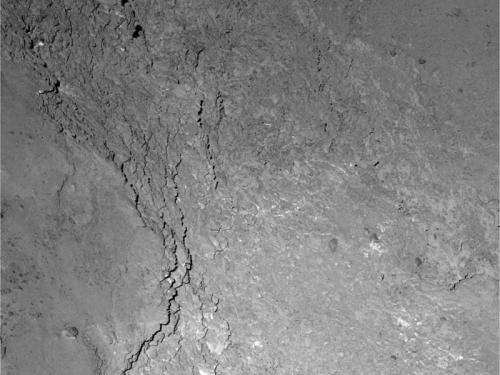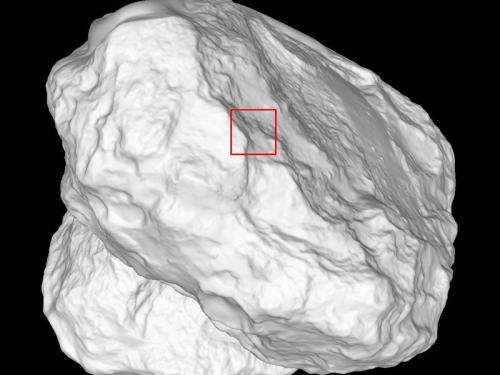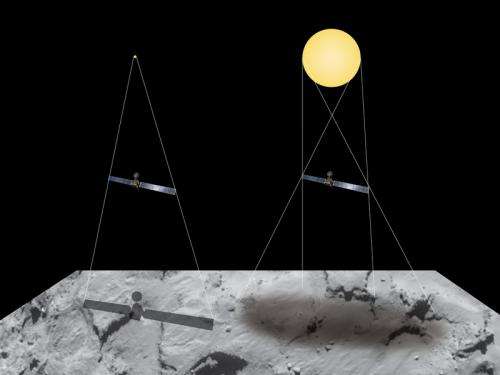OSIRIS catches glimpse of Rosetta's shadow

Several days after Rosetta's close flyby of comet 67P/Churyumov-Gerasimenko on 14 February 2015, images taken on this day by OSIRIS, the scientific imaging system on board, have now been downlinked to Earth. With a resolution of 11 centimeters per pixel, these data from OSIRIS' Narrow Angle Camera reveal highly detailed structures on the comet's surface. Since at closest approach Sun, spacecraft and comet were almost perfectly aligned, few shadows are visible in the images. With one exception: as a side-effect of this exceptional observational geometry Rosetta's shadow on the surface can be seen surrounded by a bright halo-like region.
The image released today shows an area near the edge of the comet's belly at the boundary of the Imhotep region covering 228 meters x 228 meters on the comet's surface. A mesh of steep slopes separates smooth looking terrain from a more craggy area. The image was taken from a distance of six kilometers from the comet's surface thus making structures with a pixel scale of only 11 centimeters visible. In resolution it is only surpassed by images taken by Philae's camera ROLIS on 12 November, 2015 during descent.
During the flyby Rosetta not only passed closer by a comet than ever before, but also engaged in a unique observational geometry: For a short time during the maneuver Sun, spacecraft and comet were exactly aligned. "Images taken from this viewpoint are of high scientific value", says OSIRIS Principal Investigator Holger Sierks from the Max Planck Institute for Solar System Research (MPS) in Germany. Since the surface structures cast almost no shadows, the surface's reflection properties can be discerned. "This kind of view is key for the study of grain sizes", he adds.
At the bottom of the image, Rosetta's shadow can be seen as a fuzzy rectangular-shaped dark spot measuring approximately 20 x 50 square meters. These dimensions are determined by the spacecraft's penumbra. Such penumbras occur when an object is illuminated by more than one light source – or an extended one like the Sun. In both cases light reaches the object from different directions leading to a dark core shadow where the object blocks the entire light source and an adjacent penumbra where only part of the light source is concealed. Considering the distance between Rosetta and the comet's surface, the penumbra effect leads to a shadow both 20 meters longer and wider than Rosetta's dimensions of approximately 2 x 32 square meters which is cast on the tilted surface of the comet.

In addition, the region surrounding the shadow appears brighter than the rest of the comet's surface seen in the image. Scientists refer to this effect as an opposition surge. It is known, for example, from photographs showing astronauts on the Moon and occurs typically on highly structured, regolith surfaces when light incidents from the same direction into which it is reflected. In this situation shadows normally cast by small surface grains disappear leading to a pronounced increase in brightness. This is further enhanced by the backscattering of light by the small particles on the surface of the comet.
Rosetta is an ESA mission with contributions from its member states and NASA. Rosetta's Philae lander is provided by a consortium led by DLR, MPS, CNES and ASI. Rosetta is the first mission in history to rendezvous with a comet, escort it as it orbits the Sun, and deploy a lander to its surface.

Provided by Max Planck Society





















